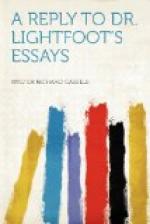He proceeds to the next “note (4)” with the same unhesitating vigour, and characterises it as “equally unfortunate.” Wherever it has been possible, Dr. Lightfoot has succeeded in misrepresenting the “purpose” of my notes, although he has recognised how important it is to ascertain this correctly, and in this instance he has done so again. I will put my text and his explanation, upon the basis of which he analyses the note, in juxtaposition, italicising part of my own statement which he altogether disregards:—
| DR. LIGHTFOOT. | “Further examination and more | “References to twenty authorities comprehensive knowledge of the | are then given, as belonging to subject have confirmed earlier | the ‘large mass of critics’ who doubts, and a large mass of critics | recognise that the Ignatian recognise that the authenticity of | Epistles ’can only be considered none of these Epistles can be | later and spurious compositions.’” established, and that they can | [73:1] only be considered later and | spurious compositions.” |
There are here, in order to embrace a number of references, two approximate states of opinion represented: the first, which leaves the Epistles in permanent doubt, as sufficient evidence is not forthcoming to establish their authenticity; and the second, which positively pronounces them to be spurious. Out of the twenty authorities referred to, Dr. Lightfoot objects to six as contradictory or not confirming what he states to be the purpose of the note. He seems to consider that a reservation for the possibility of a genuine substratum which cannot be defined invalidates my reference. I maintain, however, that it does not. It is quite possible to consider that the authenticity of the extant letters cannot be established without denying that there may have been some original nucleus upon which these actual documents may have been based. I will analyse the six references.
Bleek.—Dr. Lightfoot says:
“Of these Bleek (already cited in a
previous note) expresses no
definite opinion.”
Dr. Lightfoot omits to mention that I do not refer to Bleek directly, but by “Cf.” merely request consideration of his opinions. I have already partly stated Bleek’s view. After pointing out some difficulties, he says generally: “It comes to this, that the origin of the Ignatian Epistles themselves is still very doubtful.” He refuses to make use of a passage because it is only found in the Long Recension, and another which occurs in the Shorter Recension he does not consider evidence, because, first, he says, “The authenticity of this Recension also is by no means certain,” and, next, the Cureton Epistles discredit the others. “Whether this Recension (the Curetonian) is more original than the shorter Greek is certainly not altogether certain, but ... in the highest degree probable.” In another place he refuses




